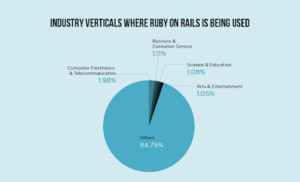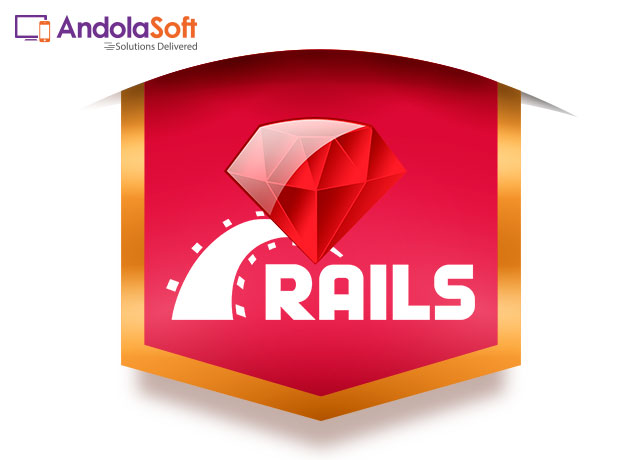Most companies whether it’s a start-up or an established enterprise have evidently landed to the conclusion that Ruby on Rails is the most viable option for rapid and cost efficient web app development.
Ruby on Rails or simply called ‘Rails’ is an open-source, full-scale multilevel web app framework that implements MVC development architecture for the Ruby programming language and is supported by a strong community around it.
Several reasons lie to use Ruby on rails, the main one is that it is a better choice than any other tools. However, before proceed forward let’s have a quick look on:
What Is Ruby On Rails?
Ruby is a dynamic, general purpose, interpreted language used for object oriented programming. The Framework has simple coding that a non-technical person can understand to some extent.
Developing new software using Ruby seems to be bit tedious. Rails, a special tool, was developed to optimize the development process.
Rails is the web development framework which is written in the Ruby language. After 9 years of development, Ruby was introduced.
Never miss an update from us. Join 10,000+ marketers and leaders.
With this development the ruby on rails developers can easily makes the web app programming.
 (Source: Clariontech)
(Source: Clariontech)
Let’s take a quick look on the features of ROR:
Mature Framework
Ruby on Rails was first released in 2003, which possessed several large and actively maintained APIs that make application development faster, easier and more manageable. One of the best examples is CSRF (Cross Site Request Forgery) protection; using which, you don’t have to do anything to add CSRF. Active Record is an extremely powerful feature in terms of building usable data models.
MVC Architecture:
With Ruby on Rails development is based on the model, controller and view pattern, widely used web application architecture. Therefore, developers using other MVC framework languages can find Ruby on Rails to be more user-friendly.
By using Ruby on Rails architecture, you can get separate codes for different functions, i.e. data layer, presentation layer, and can maintain a resource layer.
Generators/Scaffolding:
It’s a rapid prototyping tool; Rails’ scaffold will generate a starting point that allows us to list, add, remove, edit, and view things. It will explain the command, the model name and related database table, naming conventions, attributes and types.
The generated script will produce files of Ruby code that the application can use to interact with the database. It is somewhat less convenient than dynamic scaffolding, but gives the programmer the flexibility of modifying and customizing the generated APIs.
Gems/Plugin:
Ruby gems are highly portable chunks of Ruby code that can be used inside any Ruby script or application.
Rails plugins have the flexibility to hook into every part of Rails, including generators, rake tasks and tests/specs. Rails-specific features cannot be used with other Ruby frameworks like Merb, Sinatra, etc.
Active Record ORM:
Object-Relational Mapping (ORM) is a technique that connects the rich objects of an application to tables in a relational database management system.
Active record pattern is an architectural pattern found in Ruby on Rails that stores its data in relational databases. It relies heavily on the naming in that it uses class and association names to establish mappings between respective database tables and foreign key columns.
Integrated Testing Tools:
Rails features a convenient testing tool, for which, it automatically starts producing the skeleton test code in background whilst you are creating the application models and controllers.
Rails tests can also simulate browser requests and thus you can test your application’s response without having to test it over the browser.
Some convenient tools for testing Rails application:
Version Control Systems:
There are numerous version control systems. CVS was the first system widely used in the open-source community. Several years ago, it was largely replaced by Subversion (SVN). And in early 2008, most of the Rails world moved to a newer version control system, called GIT.
I’ve worked with the team at Andolasoft on multiple websites. They are professional, responsive, & easy to work with. I’ve had great experiences & would recommend their services to anyone.
Ruthie Miller, Sr. Mktg. Specialist
Salesforce, Houston, Texas
LEARN MORE
Git is usually the best choice if you are new to Ruby, because nearly all code that you need to fetch as examples or libraries will be available via a GIT repository.
Conclusion
With Ruby on Rails providing a programming framework that includes reusable, easily configurable components commonly used for creating web-based applications, it is gaining traction with developers.
From the recent studies on the job growth trends, it is seen that Ruby on Rails developers are a very hot commodity. Ruby as the language of the cloud, the job market will continue to show high demand for the developers. It’s nearly impossible to be an unemployed Ruby on Rails developer.

If you are in search of a dedicated developer, to create your ruby application, then contact us.
Our dedicated ruby developers will deliver a quick and efficient solution by developing a web application of your requirement.







